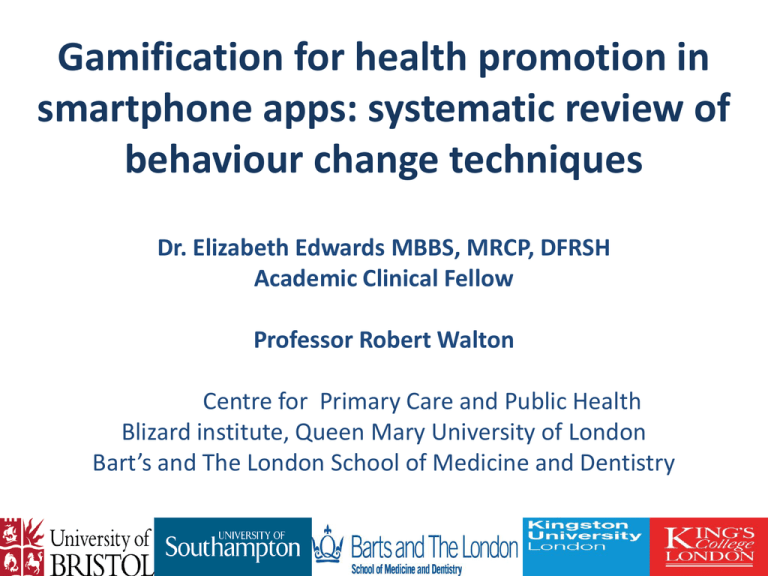Gamification for health promotion in smartphone apps: systematic review of
advertisement

Gamification for health promotion in smartphone apps: systematic review of behaviour change techniques Dr. Elizabeth Edwards MBBS, MRCP, DFRSH Academic Clinical Fellow Professor Robert Walton Centre for Primary Care and Public Health Blizard institute, Queen Mary University of London Bart’s and The London School of Medicine and Dentistry Increase in smartphone usage • Smartphone use increasing globally • Over 2 billion users worldwide 2016 • 1/3 worlds population by 2018 • Over 80% of UK population http://www.emarketer.com Globally over 500 million people use mobile health applications on smartphones Games: largest market share of apps • Most downloaded category: 33% of all downloads • 70% of app store revenue • Estimated 33.5 million (69%) of UK population aged 8-74 old, playing games, on average 14 hours per week • 52% of gamers in the UK are women, average age 31 (IAB 2014 & ukie 2015) Screen shot: Candy Crush Saga BBC News 08/12/14 Gamification & M-Health • Process of using ‘gaming’ elements to engage/motivate people in non-game contexts • Concept used by airlines, U.S. military, higher education • Relatively new concept in Mobile-Health • Gaming features effective method for modifying human behaviour & promoting healthy behaviours (Muessig E. et al., 2013, Brown J.S. et al., 1997 & Lieberman D. et al., 2013) • Systematic review: “Does Gamification work?” found gamification can influence psychological and physical outcomes (Hamari J. et al., 2014) • Promising links between gamification principles & behaviour change science (Cugelman B. et al., 2013) Cugelman B. et al., 2013 Gamification Strategies Validated behaviour change ingredients Goal setting • Agree behavioural contract • Goal setting (behaviour) Capacity to overcome challenges • Time management • Action Planning Providing feedback on performance • Prompt self-monitoring of behavioural outcome • Prompt self monitoring of behaviour Reinforcement • Provide rewards contingent on successful behaviour Compare progress • Prompt self-monitoring of behavioural outcome • Provide normative information about others behaviour Social connectivity • Social influences (norms) • Plan social support/social change Fun & Playfulness • N/A Aim of systematic review • To identify number of health & fitness apps to incorporate gamification in the official Apple & Android app stores & NHS apps library • To explore the use of behaviour change techniques • To consider association with user ratings & pricing Methods: Part one • Prospero Registration number: CRD42015029841 • Initial search: official Apple/Android app stores & NHS Health apps library in April 2014 • Medical, Health & Wellness or Health & Fitness section • Looked at ‘top-rated’ apps as defined by app stores (based on number of downloads) • Both free & purchased apps • Identified apps that contained gamification Screen shot: Official Apple, Google Play store, NHS Health apps library Inclusion Criteria Exclusion Criteria English language smartphone apps Apps designed for tablet computers Available through Google play and iTunes or NHS app store Non- English language apps Included in the Medical, Health & Wellness or Apps in other section of the stores Health & Fitness section of Google play and iTunes and all NHS apps Apps including gamification techniques: rewards, Smartphone apps that do not contain prizes, avatar use, badges, leader boards, gamification techniques competitions, health-related challenges Smartphone apps targeted at users of any age Smartphone apps designed for Health Care professionals Free and paid Smartphone apps Apps not targeting to change a physical health behaviour Apps targeting to change a physical health behaviour Flow chart of app selection process Top rated health behaviour apps for smartphones (n=1680) Apple store (n=240 medical, n=240 health & wellness) Android store (n=300 free medical, n=300 paid medical, n=300 free health & fitness, n=300 paid health & fitness) NHS app library (n=4) Excluded after screening app store entries Did not use gamification (n=1495) Not health related (n=23) Not in English (n=11) Not targeting to change a physical health behaviour (n=6) Duplicates (n=21) Designed for healthcare professionals (n=53) Potentially relevant apps identified for full evaluation (n=71) Excluded apps (n=7) No longer available (n=5) Technical difficulties (n=2) Apps included in the review (n=64) Methods: Part two • Apps meeting inclusion criteria downloaded onto test devices (LG Nexus 5 Android/iPhone 5c) • Two trained researchers screened apps independently • App content assessed against: taxonomy of behaviour change techniques (Michie S. et. al., 2013) • Explored use of Individual behaviour change techniques/ categories/ combinations • Considered associations with user ratings & price Screen shot: BCT Taxonomy Results • The median number of techniques: 14 (range 1-22) • Common combinations: – Goal setting, self-monitoring, non-specific reward and nonspecific incentive (n=35, 54.6 % apps) – Goal setting, self-monitoring and focus on past success (n= 33, 51.5 % apps) • No correlation between the number of BCTs & – App user ratings (p = 0.0715; rs = 0.227) – Price (p = 0.4464; rs = 0.097) Results: BCT Categories BCT Category Groups Number & % of Apps to use category Feedback & Monitoring n= 60 93.7% Comparison of Behaviour n= 52 81.2% Reward & Threat n= 52 81.2% Self-belief n= 51 79.6% Repetition & Substitution n= 50 78.1% Social Support n= 48 75% Goals & Planning n= 46 71.8% Shaping Knowledge n= 25 39% Associations n= 20 31.2% Antecedents n= 18 28.1% Identity n= 12 18.7% Natural Consequences n= 9 14% Comparison of Outcomes n= 5 7.8% Scheduled Consequences n= 3 4.6% Covert Learning n= 2 3.1% Regulation n= 1 1.5% Results: Individual BCTs Self-monitoring of behaviour (n=55, 85.9% apps) Social support unspecified (n=48, 75% apps) Non-specific reward (n=49, 81.6% apps) Non-specific incentive (n=49, 81.6% apps) Focus on past success (n=47, 73.4% apps) Conclusion • • • • • Relatively few apps employed gamification Majority exercise & fitness apps Self-regulatory techniques most commonly used Although apps designers using BCTs, wide variation in use Apps not being designed collaboratively with Public Health Practitioners & Health Psychologists • None of the included apps have been rigorously evaluated • Gamification could provide a potentially cost-effective platform for health behaviour change & health promotion and could have substantial Public Health impact www.healthygames.co.uk Cigbreak® Cigbreak® Cigbreak® Cigbreak® Acknowledgments Bart’s & The London School of Medicine & Dentistry Professor Robert Walton Professor Steph Taylor Professor Chris Griffiths Dr. Liz Steed Dr. Ratna Sohanpal Dr. Arun Thiyagarajan Kings College London Dr. Lindsey A Edwards Kingston University Ms. Hope Caton Healthy Games Bristol University Mr Jim Lumsden Ms. Hope Caton Mr. Robin Bell Southampton University Dr. Carol Rivas Contact email: elizabethedwards@doctors.org.uk



